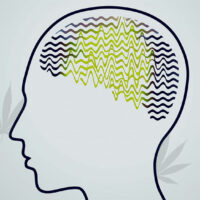In this comprehensive guide, we are exploring the research on using cannabis for treating Amyotrophic lateral sclerosis (ALS)—a rare neuron disease that targets the motor neurons in the body.
Because of the very rapid progression of ALS in the majority of patients, understanding how cannabis could help in the alleviation of symptoms is incredibly important for ALS sufferers.
The available body of evidence suggests that besides the lessening of symptoms, cannabis is also capable of slowing down the overall rate of progression of this horrible condition.
Let’s explore this in more detail.
What exactly is ALS?
Amyotrophic lateral sclerosis (usually abbreviated as ALS, and also known as motor neuron disease in the UK, and Lou Gehrig’s disease in the US) is a rare condition that causes the neurons that are in control of our voluntary muscle movement to prematurely decay and die out.
ALS rapidly lessens the patient’s ability to control the fibers of their muscle tissue, resulting in difficulties with pretty much every muscle-controlled action like walking, speaking, swallowing and even breathing. Both upper and lower motor neurons suffer severe damage in ALS patients.
The direct cause of this disease is still completely unknown, as only 5-10% of patients inherit it.
Amyotrophic lateral sclerosis is first distinguished by stiffness and muscle twitches, and later on by muscle atrophy caused by inertness.
The onset of this disease usually happens between the ages of 50 and 60, and the survival rate is typically between two to four years from the initial symptoms. As few as 10% of ALS patients live longer than 10 years after being diagnosed.
In the developing world, the rates of amyotrophic lateral sclerosis are under-investigated, but in Europe and North America ALS afflicts 2 per 100,000 people each year.
Modern science hasn’t found a cure for this condition so far, and the most frequent cause of death is respiratory failure due to muscle decay.
Brief history of ALS
The first person to describe this disorder was a Scottish scientist named Charles Bell in 1824.
In 1850, Augustus Waller first observed and illustrated the damaged and dried up nerve fibers which degenerated because of it.
French neurologist Jean-Martin Charcot coined the term amyotrophic lateral sclerosis in 1874, and in his paper, he made the connection between the symptoms and the neurological issues now commonly associated with ALS.
In 1939 this illness gained worldwide attention when the baseball legend Lou Gehrig was afflicted by it, and subsequently died from the disease two years later.
Undoubtedly, the most famous victim of ALS was the English theoretical physicist and cosmologist Stephen Hawking, who had a rare form of this illness which began very early in his life (in 1963, when he was 21).
Even though when first diagnosed doctors gave him the prognosis of only two years, he lived with ALS for 55 years.
Exploring the available research on ALS and cannabinoids
The CBD cannabinoid is proven to be an exceptional seizure-controlling agent for epilepsy patients, and also shows great promise for treating Parkinson’s, Alzheimer’s and Multiple Sclerosis.
Unfortunately, the research on amyotrophic lateral sclerosis and cannabinoids is still in its infancy, but the available body of work shows some very promising results.
The first study I will reference is from 2006, conducted on mice. In this research, scientists used a medication called AM1241, which is an artificially created cannabinoid-based CB2 agonist. An agonist is a chemical that binds to a cell receptor, causing it to perform a biological reaction.
CB2 is one of the two types of cannabinoid receptors found in all mammals (the other is CB1), and these receptors are an essential part of the endocannabinoid system, along with the corresponding cells which perform various tasks within our body.
The endocannabinoid system (ECS) is a vast network of cannabinoid receptors and correlative cells that are activated by these receptors, located in the brain, spinal cord and in vital organs and other tissues.
The ECS plays an important role in managing numerous processes, ranging from sleep, mood, immune functions, metabolism, movement and pain.
It ensures that the whole body is in homeostasis, which is an evolutionary trait of living organisms to produce equilibrium and stability in its interdependent elements, and therefore in itself.
Homeostasis is attempted (and sometimes achieved, depending on the overall health of an individual) through numerous physiological mechanisms.
Our body produces internal cannabinoids called endocannabinoids, and the compounds from the cannabis plant access the ECS in a similar manner as our own endocannabinoids.
This is how the psychoactive intoxication with THC affects our brain, and this same pathway is activated for the many other medical benefits cannabis has to offer.
The endocannabinoids are internal bioregulators, and their actions are limited to paracrine (cell to cell), or autocrine (same cell) functions.
Even though not yet completely understood by science, the functions of the endocannabinoids are primarily beneficial, but they can also contribute to many negative effects (insulin sensitivity, metabolic issues, inflammation), however, this only happens if the ECS isn’t functioning properly when the body is not in homeostasis.
This is where the cannabinoids from cannabis come into play, as we can now get back to the mice who helped us understand how to help ALS patients.
Research has identified that even though the primary pathology of ALS is motor neuron degeneration, other non-neuronal cells also contribute to the swift advancement of this disease, particularly the inflammation processes that accompany it.
So, the cannabinoid-based AM1241 medication helped with slowing down the progression of ALS by lessening the inflammation and hyperalgesia. (1)
The overall progress of ALS was significantly slowed down through the diminished inflammation, and because of the natural basis of AM1241, the medication was extremely well tolerated by mice.
In 2010, another pre-clinical study was also conducted on mice, and published in the American Journal of Hospice and Palliative Care.
The results of this research showed even more evidence for the effect of cannabis against the rapid onset of the disease, and also for the overall lessening of ALS symptoms.
A team of scientists in charge of the study concluded that cannabinoids from cannabis possess the versatile effects needed to fight the intricate and complex nature of amyotrophic lateral sclerosis. (2)
These effects are:
- Antioxidative characteristics
- Anti-inflammatory characteristics
- Neuroprotective characteristics
According to their findings, cannabis increased glutamate uptake which controls the excitability of the brain cells and improved mitochondrial function (mitochondria is an organelle, a part of the cell that creates energy for that specific cell).
Cannabinoids also enhanced neurotrophic growth factors, molecules that aid the survival and growth of both new and mature neurons.
Improved engagement of microglial cells is also one of the functions of cannabis that is beneficial for ALS symptoms. Microglias are immune system cells, located specifically in the brain and the spinal cord.
Lastly, the study concluded that cannabis enhanced the activity of anti-apoptotic agents, which are in charge of preventing cell-death, also known as apoptosis.
This study pointed out that cannabis may have other useful mechanisms for alleviating ALS symptoms, including saliva reduction, aiding with sleep, an increase in appetite, pain reduction, relaxation of the muscles and bronchodilation effects.
Even though these effects were observed on mice, all mammals have neurological and cellular similarities, and the team in charge of this study concluded that:
“With respect to the treatment of ALS, from both a disease modifying and symptom management viewpoint, clinical trials with cannabis are the next logical step. Based on the currently available scientific data, it is reasonable to think that cannabis might significantly slow the progression of ALS, potentially extending life expectancy and substantially reducing the overall burden of the disease.”
Human studies and surveys on using cannabis for ALS
Also presented in the American Journal of Hospice and Palliative Care, a 2004 survey set about to discover the effect of cannabis use on ALS in humans.
Their method was to ask 131 ALS patients various questions, 13 of which were about self-medicating with cannabis for at least 12 months prior to the survey.
The results were quite positive, as the patients reported diverse benefits from their use of the cannabis plant. (3)
One of the main advantages included relief from depression, which generally accompanies ALS to some degree—the mind remains completely intact as the disease advances, which makes the disease truly devastating.
Patients also reported a reduction in pain, increased appetite and reduced muscle spasticity.
All these findings correlate with the conclusions of the scientists who were involved in the mice study from 2010.
Unfortunately, the amount and type of cannabis the patients in this survey used for therapy is unknown.
The year of 2012 saw a collaborative effort between a nonprofit organization PatientsLikeMe, and a professional academic research team.
The researchers surveyed 48 ALS patients (within the PatientsLikeMe community) who were using cannabis to alleviate their symptoms, and then analyzed the data the patients supplied them with.
They subsequently published a paper which includes findings on the symptoms cannabis helped lessen and also provides data on the negative side of their cannabis use.
The positive influence of cannabis included improvements in speech, appetite, mood, sleep, swallowing, fasciculations, and easier stool and urine discharge. (4)
As for the side effects of cannabis consumption, patients noted vertigo, soreness of throat, dry mouth, red eyes and difficulties with coordination.
The sore throat sensations likely would have been avoided by alternative and healthier methods of cannabis use, such as edibles, vaporizers and topical creams infused with cannabinoids.
Another study, published in 2015, focused on the differences between regular cannabis and dronabinol, mainly for ALS patients.
The scientists concluded that dronabinol had more severe side effects than regular cannabis, that it provided too much sedation, and also that the psychoactivity of this artificial tetrahydrocannabinol was greater than the natural substance. (5)
Synthetic cannabinoids are legal in many countries where cannabis isn’t, because of their “non-cannabis origin”, but of course they were also created so that the medical industry could patent the medicine.
The only upside of dronabinol is that it can be a THC substitute where cannabis isn’t legalized, but besides that, it is a very poor alternative to the real thing.
Consuming the entire plant is much more beneficial because of the “entourage effect” produced.
This phrase was coined by Raphael Mechoulam and Ben Shabat, and describes how cannabinoids and terpenes interact to diminish each other’s negative effects (for instance CBD lessens the psychoactivity of THC).
Cannabidiol (CBD) and ALS
As the nature of amyotrophic lateral sclerosis requires several functions of cannabis to happen at the same time, including antioxidative, anti-inflammatory and neuroprotective mechanisms, treating ALS with only one isolated cannabinoid (either THC or CBD) wouldn’t be effective because of the lack of the entourage effect.
CBD could offer some relief, but for the full effect, whole-flower extracts should be used because they contain both cannabinoids and terpenes.
What is the best strain for ALS?
Before you consider buying cannabis to alleviate symptoms of ALS, it’s crucial to check your state’s regulations regarding the medical use of cannabis. Taking Florida as an example, where cannabis is legal only for medical purposes, individuals with qualifying conditions, including ALS, may be eligible to obtain a medical marijuana card. To understand the process of how to get a medical marijuana card in Florida, it’s recommended to research and follow the guidelines provided by the state’s Department of Health or consult with a qualified healthcare professional.
Choosing the perfect strain for ALS is difficult, because of the complicated nature of the disease. There are a few things that a patient needs to consider for the best possible results.
First, consuming pure Sativas or Sativa-dominant hybrids is most likely a bad choice because of the energizing trait of these strains.
Secondly, the reason Indicas are likely a better choice is the unique combination of THC and healing terpenes found in those strains.
The third and final factor is CBD. The presence of both cannabinoids seems crucial for ALS patients because each provides their own distinct benefits, which are required for the alleviation of complex ALS symptoms.
My suggestion would be to try several strains that are:
- Pure Indicas (or Indica-dominants)
- High in THC
- Have significant CBD levels (or 1:1 THC-CBD ratio)
The individual chemistry of each person is the reason why you should always try several different options, so you can determine which strain works best for you.
Summary
When we take into account all this information, Canadian authorities should definitely consider adding ALS to the list of conditions that qualifies a patient for medical cannabis as soon as possible.
Additional clinical studies will surely reveal new promising benefits of cannabis for ALS, and help us understand the mechanisms behind it with more precision.
References
- Kim K, Moore DH, Makriyannis A, Abood ME; AM1241, a cannabinoid CB2 receptor selective compound, delays disease progression in a mouse model of amyotrophic lateral sclerosis; European Journal of Pharmacology, August 2006, Pages 100-105
- Carter GT, Abood ME, Aggarwal SK, Weiss MD; Cannabis and Amyotrophic Lateral Sclerosis: Hypothetical and Practical Applications, and a Call for Clinical Trials; American Journal of Hospice and Palliative Medicine, May 2010
- Amtmann D1, Weydt P, Johnson KL, Jensen MP, Carter GT; Survey of cannabis use in patients with amyotrophic lateral sclerosis; American Journal of Hospice and Palliative Medicine, March 2004, Pages 95-104
- Carter GT, Bedlack R, Hardiman O, Pastula DM; ALSUntangled No. 16: Cannabis; June 2012, Pages 400-404
- Richard S. Bedlack, MD, PhD,1 Nanette Joyce, DO,2 Gregory T. Carter, MD, MS,3 Sabrina Paganoni, MD, PhD,4 and Chafic Karam; Complementary and Alternative Therapies in ALS; Neurologic Clinics, November 2015, Pages Pages 909-936






Kittima March 17, 2019 at 2:20 am
Thank you very much for a comprehensive summary. Do you have any update on this front (in 2019) whether the ALS has been added to the list of conditions qualifying for medical cannabis?
Marco March 18, 2019 at 10:26 am
You're very welcomed Kittima, and can you please let me know what state/province/country you're asking about, so I can check out if ALS was added to the list of qualifying conditions.
Eliana Caceres April 10, 2019 at 10:28 pm
Very good article Marco...what brand of CBD oil do you recommend for patients with ALS and those uncomfortable pains in arms while sleeping in bed at night...
Marco April 11, 2019 at 10:34 am
Hey Eliana, amyotrophic lateral sclerosis requires several functions of cannabis to happen at the same time, including antioxidative, anti-inflammatory and neuroprotective mechanisms, so treating ALS with only with CBD wouldn’t be effective. Try using either: - Pure Indicas (or Indica-dominants) that are high in THC - Strains with significant CBD levels (for instance 1:1 THC-CBD ratio)
hemp cbd September 14, 2020 at 5:08 pm
CBD for the win!